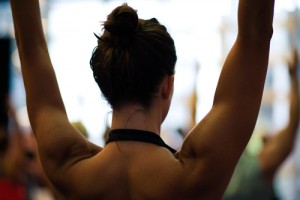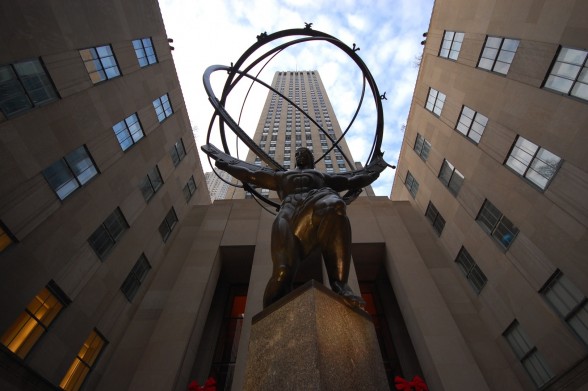a·plomb /əˈpläm/

The great ballet mistress Agrippina Vaganova said, “the stem of aplomb is the spine”. In dance, aplomb is also used to describe stability as achieved through correct posture, placement and alignment. None of this can be achieved without involving what I consider to be the “life source” of dance: the spine.
The main function of the spine, in people in general and certainly in dancers, is to support the weight of the head, rib cage, and shoulder girdle. The majority of this weight is transferred to the pelvis, where the center of gravity is located.
We often think of the spine as one “thing” but in reality it is a series of 24 individual bones connected by intervertebral discs (excluding the nine fused bones of the sacrum and coccyx). I like to think of the spine as a “system”, instead of a thing, because each of its parts is affected by and dependent on the others.
The Cervical Spine (below) is Part I of a three-part series.
Part II – The Thoracic Spine
Part III – The Lumbar Spine, Sacrum, and Coccyx
On top of it all – The Cervical Spine
The Cervical Spine, seven tiny bones that carry the weight of the world, so to speak. Though small, these mighty bones are responsible for all movements of the head and neck, and make up the most mobile section of the spine.
Structure:
 The seven bones of the cervical spine are labeled C1-C7. Together, these bones form the concave top end of the spinal column, and (with the exception of C1 and C2) have common characteristics that they share with all the other vertebrae. Specifically, there is a central body with three extensions, or processes. The two transverse processes extend to the side of the body, and the spinous process is the single middle extension. You can feel (or palpate) the spinous processes of several vertebrae down the length of your spine. C7, or the last of the cervical vertebrae, is very prominent and can be felt easily by tilting your head forward and touching the base of your neck. The opening between the body of each vertebra and the spinous process is where the spinal cord passes en route to the brain. So, it’s safe to say, these little bones have a lot going on.
The seven bones of the cervical spine are labeled C1-C7. Together, these bones form the concave top end of the spinal column, and (with the exception of C1 and C2) have common characteristics that they share with all the other vertebrae. Specifically, there is a central body with three extensions, or processes. The two transverse processes extend to the side of the body, and the spinous process is the single middle extension. You can feel (or palpate) the spinous processes of several vertebrae down the length of your spine. C7, or the last of the cervical vertebrae, is very prominent and can be felt easily by tilting your head forward and touching the base of your neck. The opening between the body of each vertebra and the spinous process is where the spinal cord passes en route to the brain. So, it’s safe to say, these little bones have a lot going on.
The atlas and the axis (C1 and C2, respectively) are the only vertebrae that break the structural trends of body – transverse processes – spinous process. These exceptional bones are what make it possible to turn your head in any direction, limited only by the tightness of our individual musculature. The atlas is so named after the legendary Greek myth in which Atlas was forced to hold the heavens above his head. In this case, the “heavens” are analogous to your noggin – as the atlas bone supports the entire weight of your head on the spine.

Function:
As I’ve alluded to a couple of times, the cervical spine is the most mobile of all spinal sections, enabling movement of the head in all directions in addition to flexion and extension, lateral flexion and rotation of the neck itself. You can feel the cervical spine in action by putting your hand on C7 (previously discussed as that biggest knob at the base of your neck) and moving your neck around in each direction. Pretty cool, if you ask me.
How does this information help me in dance?
Good question…At the top of the article, I quoted the great Agrippina Vaganova, who calls the spine the “stem of aplomb”. The way that a dancer carries his/her head, the length of the neck, and the position of the chin, are pivotal to the overall appearance of grace and poise so necessary in dance.
Two common errors I see in young dancers are collapsing the neck in cambré derrière, and poking the chin forward.
Cambré derrière dissected:
Though we often state that the top of the head is the starting point for back bends, this movement truly initiates from the cervical spine (read: the head itself has no joints, but provides a good image for lifting up before arching back). Many young and/or novice dancers cannot support the weight of their heads past a certain point, and as a result the head collapses backward. Not only does this break the aesthetic line of the arch, but isn’t good for your neck. The most common and functional solution is to ask the dancer to turn the head to the side, so that the weight of the head is supported by the strong Sternocleidomastoid muscle (SCM, for short). You can see this muscle working by performing the cambré with your head to the side – it’s that protrusion on the side of your neck that wraps from just beneath your ear to your sternum. This is a perfect example of how dance technique has evolved to not only cater to our aesthetic sensibilities, but also to protect us from injury.
Chin back, shoulders down:
Many dancers have the habit of standing with their chins poking forward. Correcting a chin “poker” can be especially challenging because of the way the spine is structured. Though divided into sections, each part of the spinal column is interdependent on all the others, that is, changing the curve of the cervical spine affects the curvature of the thoracic and lumbar spines as well. I’ll get to more on those sections in later installments…
My point is: a dancer can’t simply pull her chin back without potentially creating other problems. A poking chin is often the result of an attempt to lower the shoulders, and many times accompanied by splayed ribs and a swayed lower back. Putting it back can create the opposite problem, curving the shoulders forward, rounding the middle back, and sometimes tucking the pelvis.
While it IS possible to isolate the movement of each spinal section, it’s extremely difficult for young dancers to accomplish. Instead of allowing dancers to bounce from one extreme to another, it is often helpful to simply encourage them to elongate the spine as a whole. This softens each of its curves, enhances flexibility of each spinal section, and stacks each vertebra on the next. I love the image of the head “floating” on top of the spine, as though it were the top piece on a pyramid of dominos. It must be light and perfectly placed, or the whole structure is affected.
Deep thoughts
Skyscrapers are built using straight lines. Regardless of your personal belief system, religion, philosophy or mantra, The Architect of the human body is irrefutably brilliant far beyond our comprehension.
I can’t imagine staring up at the Hancock building in Chicago or the Eiffel Tower in Paris and seeing the heaviest part of the building resting on top of seven thin blocks arranged in a curve. I don’t know why it works, but I know that it does. Designed in any different way, and we dancers would have no subtle movements of the head, no forward or back bends, no aplomb.
I once had an adult student who had five fused cervical vertebrae, and she found it exceptionally difficult to participate in dance. Almost everything we did was possible for her, but my impression was that she lost interest because she never felt that joyous lift through the top of her spine that we dancers thrive on.
Your turn:
What corrections do you find yourself giving relating to the neck and spine??
References:
-
Grieg, V. (1994). Inside Ballet Technique: Separating Anatomical Fact from Fiction in the Ballet Class
. Hightstown, NJ: Princeton Book Company.
-
Marieb, E.N. (2003). Human Anatomy and Physiology, sixth edition. Benjamin Cummings. (8th Edition found here)
-
Vaganova, A. (1969). Basic Principles of Classical Ballet
. New York: Dover Publications.
Lauren Warnecke is a freelance writer and editor, focused on dance and cultural criticism in Chicago and across the Midwest. Lauren is the dance critic for the Chicago Tribune, editor of See Chicago Dance, and founder/editor of Art Intercepts, with bylines in Chicago Magazine, Milwaukee Magazine, St. Louis Magazine and Dance Media publications, among others. Holding degrees in dance and kinesiology, Lauren is an instructor of dance and exercise science at Loyola University Chicago. Read Lauren’s posts.

